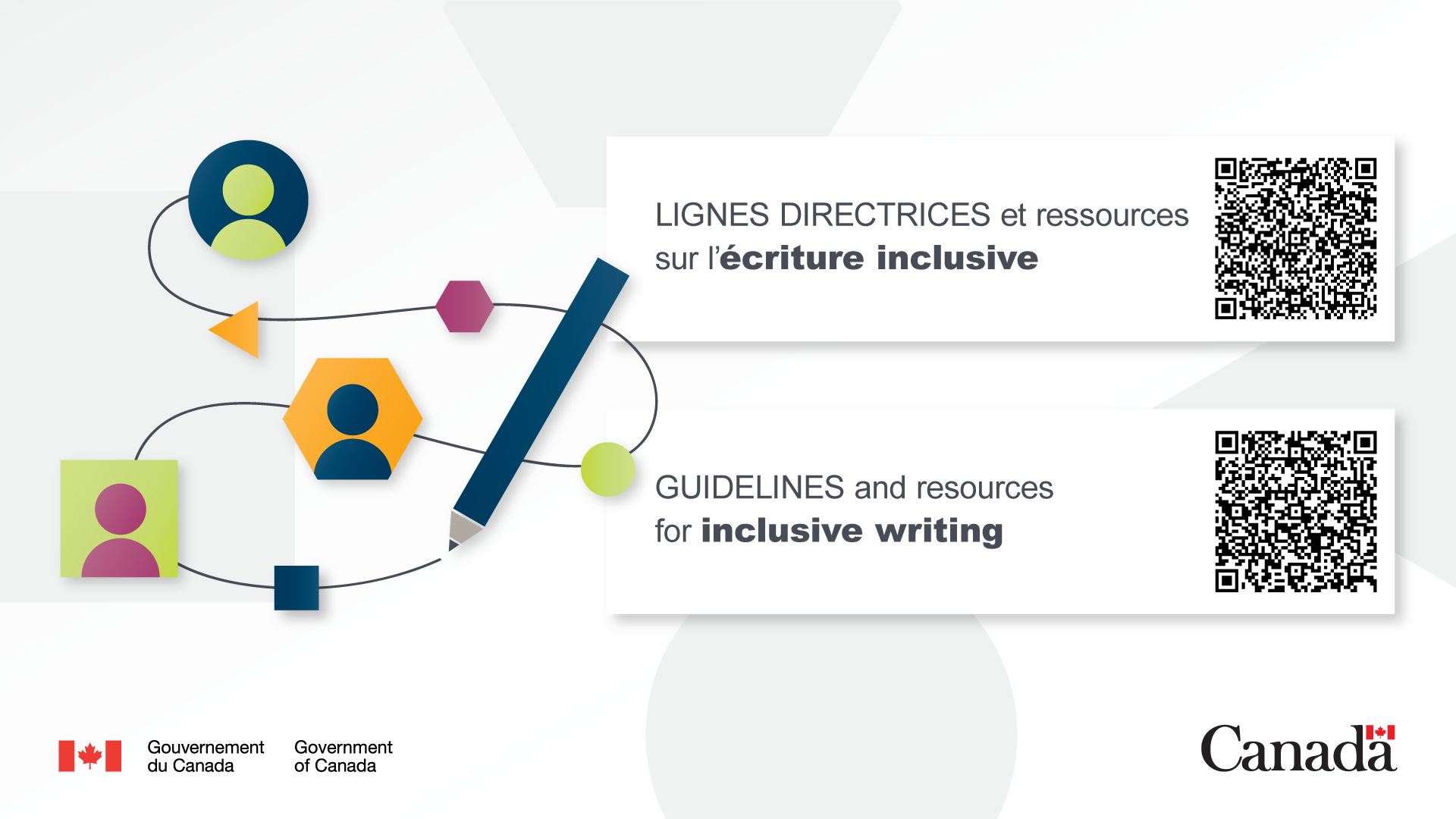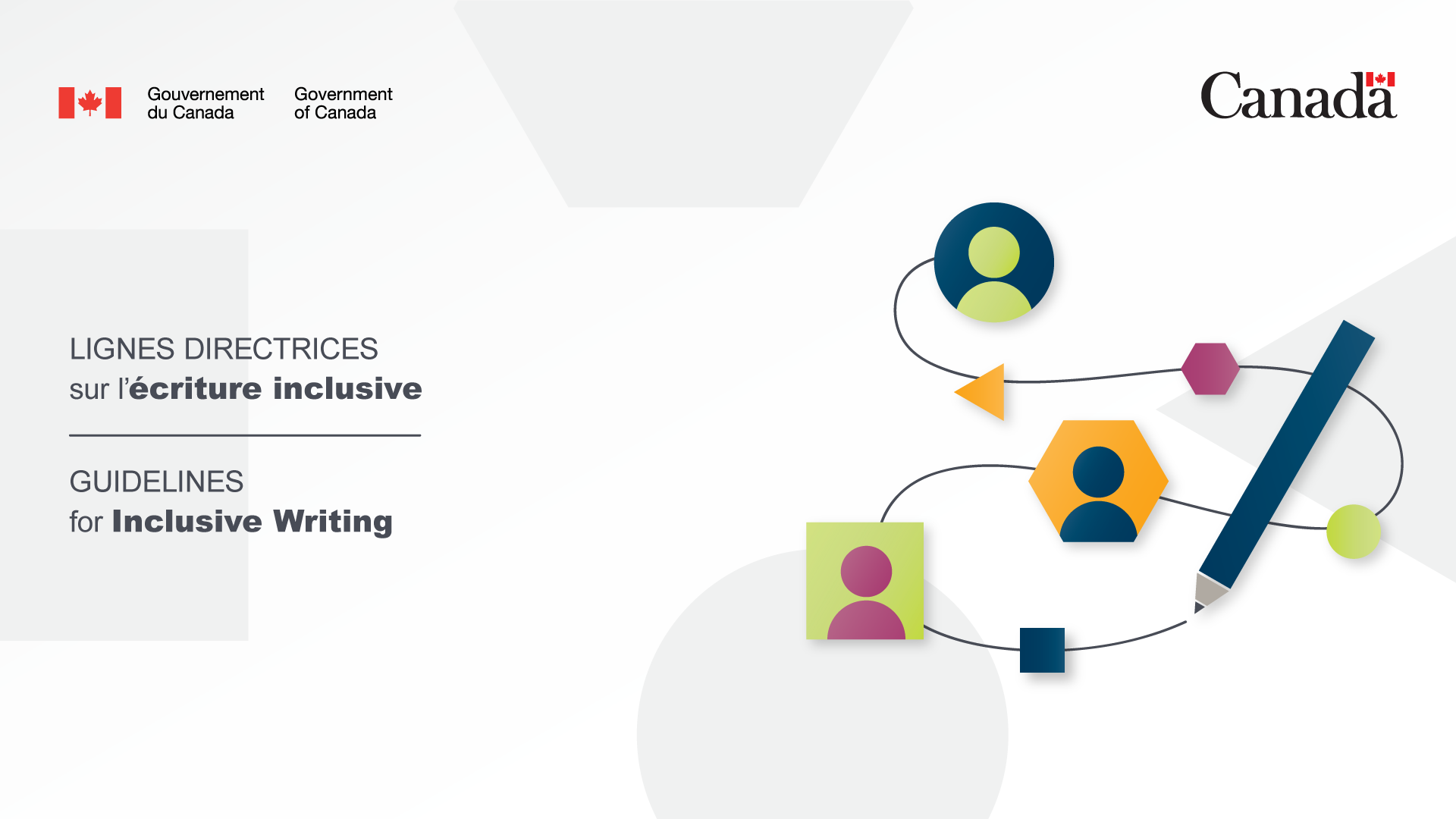Important: The GCConnex decommission will not affect GCCollab or GCWiki. Thank you and happy collaborating!
Difference between revisions of "Promotional kit for the Guidelines for Inclusive Writing"
m |
m |
||
| Line 254: | Line 254: | ||
Want to write more inclusively in English or French? Looking for inclusive writing principles and techniques to help you do just that? You can now access the [https://www.noslangues-ourlanguages.gc.ca/en/writing-tips-plus/inclusive-writing-guidelines-resources Guidelines for Inclusive Writing] on the Language Portal of Canada! | Want to write more inclusively in English or French? Looking for inclusive writing principles and techniques to help you do just that? You can now access the [https://www.noslangues-ourlanguages.gc.ca/en/writing-tips-plus/inclusive-writing-guidelines-resources Guidelines for Inclusive Writing] on the Language Portal of Canada! | ||
| − | The Guidelines for Inclusive Writing are designed to help the federal public service and any other organization produce writing that is free of discrimination based on gender, race, ethnicity or any other identity factor. The Guidelines outline principles for writing inclusive texts and describe practical techniques to use in various contexts. Another new resource is the [https://www.noslangues-ourlanguages.gc.ca/en/writing-tips-plus/inclusionary Inclusionary] and its French counterpart, [https://www.noslangues-ourlanguages.gc.ca/en/cles-de-la-redaction/ecriture-inclusive-inclusionnaire Inclusionnaire], which can help you find inclusive alternatives to gendered words and expressions. | + | The Guidelines for Inclusive Writing are designed to help the federal public service and any other organization produce writing that is free of discrimination based on gender, race, ethnicity or any other identity factor. The Guidelines outline principles for writing inclusive texts and describe practical techniques to use in various contexts. Another new resource is the [https://www.noslangues-ourlanguages.gc.ca/en/writing-tips-plus/inclusionary Inclusionary] and its French counterpart, the [https://www.noslangues-ourlanguages.gc.ca/en/cles-de-la-redaction/ecriture-inclusive-inclusionnaire Inclusionnaire], which can help you find inclusive alternatives to gendered words and expressions. |
The Guidelines and the collections of inclusive solutions were developed by the Interdepartmental Working Group on Inclusive Writing, which is co‑chaired by Public Services and Procurement Canada (represented by the Translation Bureau), Women and Gender Equality Canada, and Canadian Heritage, and composed of various federal and provincial departments and agencies. These resources underwent extensive consultations with equity, diversity and inclusion networks, and language professionals and communications specialists. | The Guidelines and the collections of inclusive solutions were developed by the Interdepartmental Working Group on Inclusive Writing, which is co‑chaired by Public Services and Procurement Canada (represented by the Translation Bureau), Women and Gender Equality Canada, and Canadian Heritage, and composed of various federal and provincial departments and agencies. These resources underwent extensive consultations with equity, diversity and inclusion networks, and language professionals and communications specialists. | ||
Revision as of 12:38, 23 September 2022
| Version française |
Are you interested in promoting the Guidelines for Inclusive Writing? The team at the Language Portal of Canada, a website managed by Public Services and Procurement Canada’s Translation Bureau, has put together a promotional kit with everything you need to do just that. The kit includes bilingual promotional messages and graphics tailored to various types of communication and promotion.Simply go to the section on this page entitled "Downloadable version" to access the turnkey products that are best suited to your communication needs. You can also consult the promotional kit for the Guide on Equity, Diversity and Inclusion Terminology. |

|
DOWNLOADABLE VERSION
In this section, you’ll find turnkey promotional messages that you can download.
SOCIAL MEDIA
Please note that you should use the hashtags #GoC, #InclusiveWriting and #diversity in English and #GC, #ÉcritureInclusive and #diversité in French. They have been included in the social media messages prepared for publication.
| TWITTER |
|
The #GoC has just released its Guidelines for #InclusiveWriting online! You’ll find practical techniques for #writing texts that are #inclusive and respectful of #diversity. Bookmark this link! https://www.noslangues-ourlanguages.gc.ca/en/writing-tips-plus/inclusive-writing-guidelines-resources |
Le #GC vient de mettre en ligne ses Lignes directrices sur l’#ÉcritureInclusive! Vous y trouverez des procédés concrets qui vous aideront à #rédiger des textes #inclusifs et respectueux de la #diversité. Conservez ce lien dans vos favoris! https://www.noslangues-ourlanguages.gc.ca/fr/cles-de-la-redaction/ecriture-inclusive-lignes-directrices-ressources |
To ensure your writing is respectful of #diversity, check out the #GoC’s Guidelines for #InclusiveWriting! The Guidelines feature the principles of inclusive writing, practical techniques and a collection of gender-inclusive solutions. Give them a try! https://www.noslangues-ourlanguages.gc.ca/en/writing-tips-plus/inclusive-writing-guidelines-resources |
Pour rédiger d'une façon respectueuse de la #diversité, consultez les Lignes directrices sur l'#ÉcritureInclusive du #GC! Elles présentent les principes à suivre, des procédés d’écriture concrets et un recueil de solutions inclusives. Adoptez-les! https://www.noslangues-ourlanguages.gc.ca/fr/cles-de-la-redaction/ecriture-inclusive-lignes-directrices-ressources |
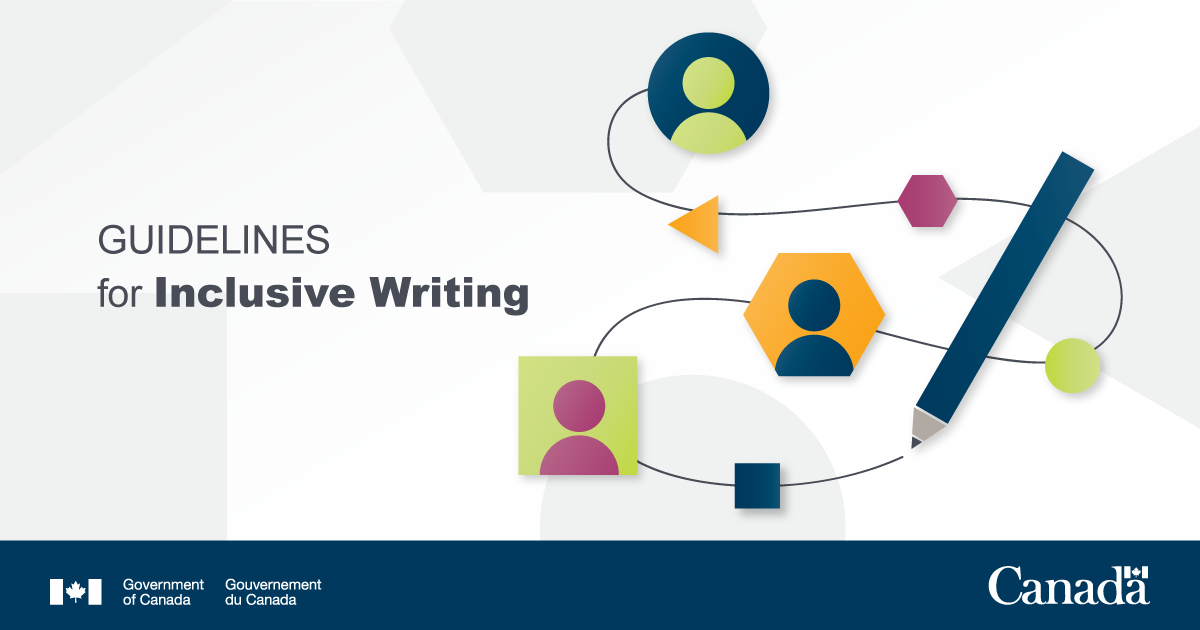 Download the image |
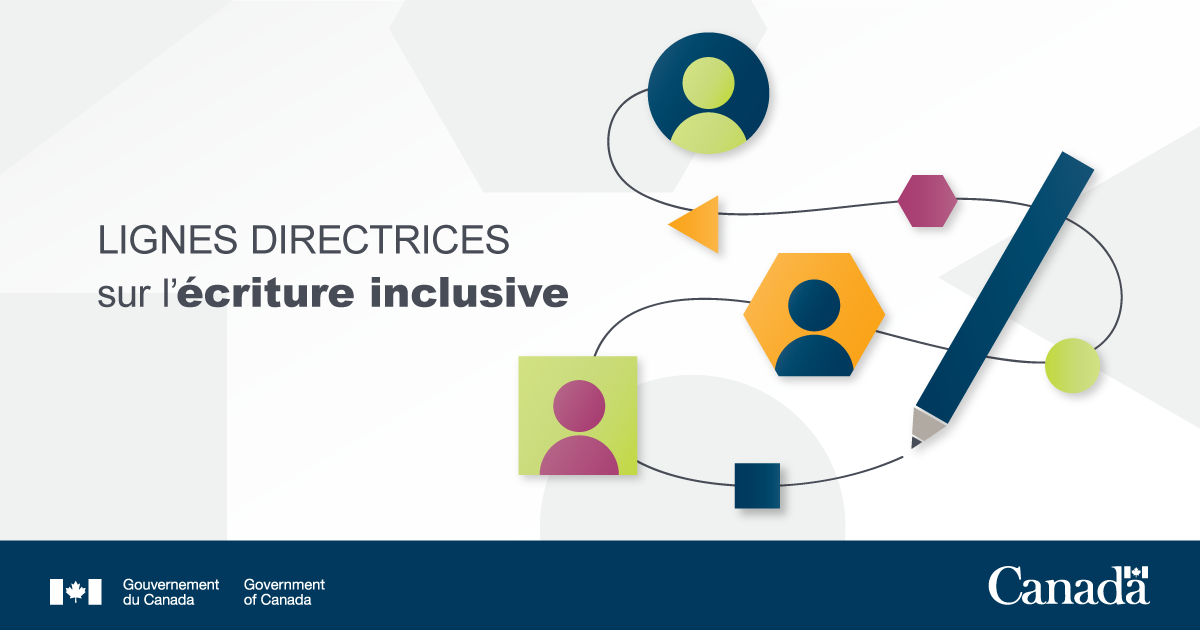 Download the image |
| FACEBOOK |
|
To help the federal public service communicate with Canadians in a way that is respectful of their #diversity, the #GoC has just published Guidelines for Inclusive Writing. These guidelines provide practical techniques for writing texts that are free of discrimination based on gender, race, ethnicity or any other identity factor. Check out the Guidelines for ways to keep your communications clear and efficient while applying the principles of #InclusiveWriting! https://www.noslangues-ourlanguages.gc.ca/en/writing-tips-plus/inclusive-writing-guidelines-resources |
Pour aider la fonction publique fédérale à communiquer avec la population canadienne dans le respect de sa #diversité, le #GC vient de publier des Lignes directrices sur l’écriture inclusive. Elles présentent des procédés concrets à employer pour rédiger des textes exempts de discrimination liée au genre, à la race, à l’origine ethnique ou à tout autre facteur identitaire. Consultez-les, vous verrez qu'il est possible de communiquer de façon claire et efficace tout en appliquant les principes d'#ÉcritureInclusive! https://www.noslangues-ourlanguages.gc.ca/fr/cles-de-la-redaction/ecriture-inclusive-lignes-directrices-ressources |
To draft communications that are truly respectful of #diversity, use the #GoC’s Guidelines for Inclusive Writing! You’ll find practical techniques for writing texts that are free of discrimination based on gender, race, ethnicity or any other identity factor. And make sure to check out the Inclusionary, a collection of gender-inclusive solutions.
The Guidelines were developed by an interdepartmental working group co‑chaired by @PSPC.SPAC (#TranslationBureau), @wage.fegc and @CdnHeritage and composed of over 35 Canadians departments and agencies. Extensive consultations were also conducted with various groups, including networks representing #GenderDiversity and #SexualDiversity communities. Bookmark this link! https://www.noslangues-ourlanguages.gc.ca/en/writing-tips-plus/inclusive-writing-guidelines-resources #InclusiveWriting #InclusiveCommunication |
Pour des communications véritablement respectueuses de la #diversité, adoptez les Lignes directrices sur l'écriture inclusive du #GC! Vous y trouverez des procédés concrets à employer pour rédiger des textes exempts de discrimination liée au genre, à la race, à l’origine ethnique ou à tout autre facteur identitaire. Consultez aussi l'Inclusionnaire, un recueil pratique de solutions inclusives.
Plus de 35 ministères et organismes du Canada, membres d’un groupe de travail interministériel coprésidé par @SPAC.PSPC (#BureauDeLaTraduction), @fegc.wage et @Patrimoinecdn, ont contribué à l’élaboration de ces lignes directrices. Des consultations élargies ont aussi été menées entre autres auprès de réseaux représentant les communautés de la #DiversitéSexuelle et de genre. Conservez ce lien dans vos favoris! https://www.noslangues-ourlanguages.gc.ca/fr/cles-de-la-redaction/ecriture-inclusive-lignes-directrices-ressources #ÉcritureInclusive #RédactionInclusive #CommunicationInclusive |
 Download the image |
 Download the image |
| LINKEDIN |
|
To help the federal public service communicate with Canadians in a way that is respectful of their #diversity, the #GoC has just published Guidelines for Inclusive Writing. These guidelines provide practical techniques for writing texts that are free of discrimination based on gender, race, ethnicity or any other identity factor. Check out the Guidelines for ways to keep your communications clear and efficient while applying the principles of #InclusiveWriting! https://www.noslangues-ourlanguages.gc.ca/en/writing-tips-plus/inclusive-writing-guidelines-resources |
Pour aider la fonction publique fédérale à communiquer avec la population canadienne dans le respect de sa #diversité, le #GC vient de publier des Lignes directrices sur l’écriture inclusive. Elles présentent des procédés concrets à employer pour rédiger des textes exempts de discrimination liée au genre, à la race, à l’origine ethnique ou à tout autre facteur identitaire. Consultez-les, vous verrez qu'il est possible de communiquer de façon claire et efficace tout en appliquant les principes d'#ÉcritureInclusive! https://www.noslangues-ourlanguages.gc.ca/fr/cles-de-la-redaction/ecriture-inclusive-lignes-directrices-ressources |
To draft communications that are truly respectful of #diversity, use the #GoC’s Guidelines for Inclusive Writing! You’ll find practical techniques for writing texts that are free of discrimination based on gender, race, ethnicity or any other identity factor. And make sure to check out the Inclusionary, a collection of gender-inclusive solutions.
The Guidelines were developed by an interdepartmental working group co-chaired by Public Services and Procurement Canada @pspc-spac (#TranslationBureau), Women and Gender Equality Canada @fegc-wage and Canadian Heritage @canadian-heritage-patrimoine-canadien and composed of over 35 Canadian departments and agencies. Extensive consultations were also conducted with various groups, including networks representing #GenderDiversity and #SexualDiversity communities Bookmark this link! https://www.noslangues-ourlanguages.gc.ca/en/writing-tips-plus/inclusive-writing-guidelines-resources #InclusiveWriting #InclusiveCommunication |
Pour des communications véritablement respectueuses de la #diversité, adoptez les Lignes directrices sur l'écriture inclusive du #GC! Vous y trouverez des procédés concrets à employer pour rédiger des textes exempts de discrimination liée au genre, à la race, à l’origine ethnique ou à tout autre facteur identitaire. Consultez aussi l'Inclusionnaire, un recueil pratique de solutions inclusives.
Plus de 35 ministères et organismes du Canada, membres d’un groupe de travail interministériel coprésidé par Services publics et Approvisionnement Canada @pspc-spac (#BureauDeLaTraduction), Femmes et Égalité des genres Canada @fegc-wage et Patrimoine canadien @canadian-heritage-patrimoine-canadien, ont contribué à l’élaboration de ces lignes directrices. Des consultations élargies ont aussi été menées entre autres auprès de réseaux représentant les communautés de la #DiversitéSexuelle et de genre Conservez ce lien dans vos favoris! https://www.noslangues-ourlanguages.gc.ca/fr/cles-de-la-redaction/ecriture-inclusive-lignes-directrices-ressources #ÉcritureInclusive #RédactionInclusive #CommunicationInclusive |
 Download the image |
 Download the image |
| INSTAGRAM |
|
When it comes to #InclusiveWriting, words matter! To help public service employees produce inclusive communications, a #GoC interdepartmental working group consulted with more than 35 Canadian organizations to develop the Guidelines for Inclusive Writing. Check out these guidelines to find practical techniques for writing texts that are free of discrimination based on gender, race, ethnicity or any other identity factor. https://www.noslangues-ourlanguages.gc.ca/en/writing-tips-plus/inclusive-writing-guidelines-resources
#InclusiveWriting #InclusiveCommunication #equity #inclusion #InclusionAndDiversity #SexualDiversity #GenderDiversity #NonBinary #GenderNeutralWriting #LGBTQ+ #WomensRepresentation |
Il est important de bien choisir ses mots à l'écrit dans une optique d’inclusion. Pour aider les fonctionnaires à produire des communications inclusives, un groupe de travail interministériel du #GC a consulté plus de 35 organisations du Canada. Les Lignes directrices sur l'écriture inclusive sont le fruit de ce travail collaboratif. Consultez-les pour connaître les procédés concrets à employer pour rédiger des textes exempts de discrimination liée au genre, à la race, à l’origine ethnique ou à tout autre facteur identitaire. https://www.noslangues-ourlanguages.gc.ca/fr/cles-de-la-redaction/ecriture-inclusive-lignes-directrices-ressources
##ÉcritureInclusive #RédactionInclusive #CommunicationInclusive #équité #inclusion #InclusionEtDiversité #DiversitéSexuelle #DiversitéDeGenre #NonBinarité #ÉcritureNonGenrée #2ELGBTQI+ #ReprésentationDesFemmes #féminisation |
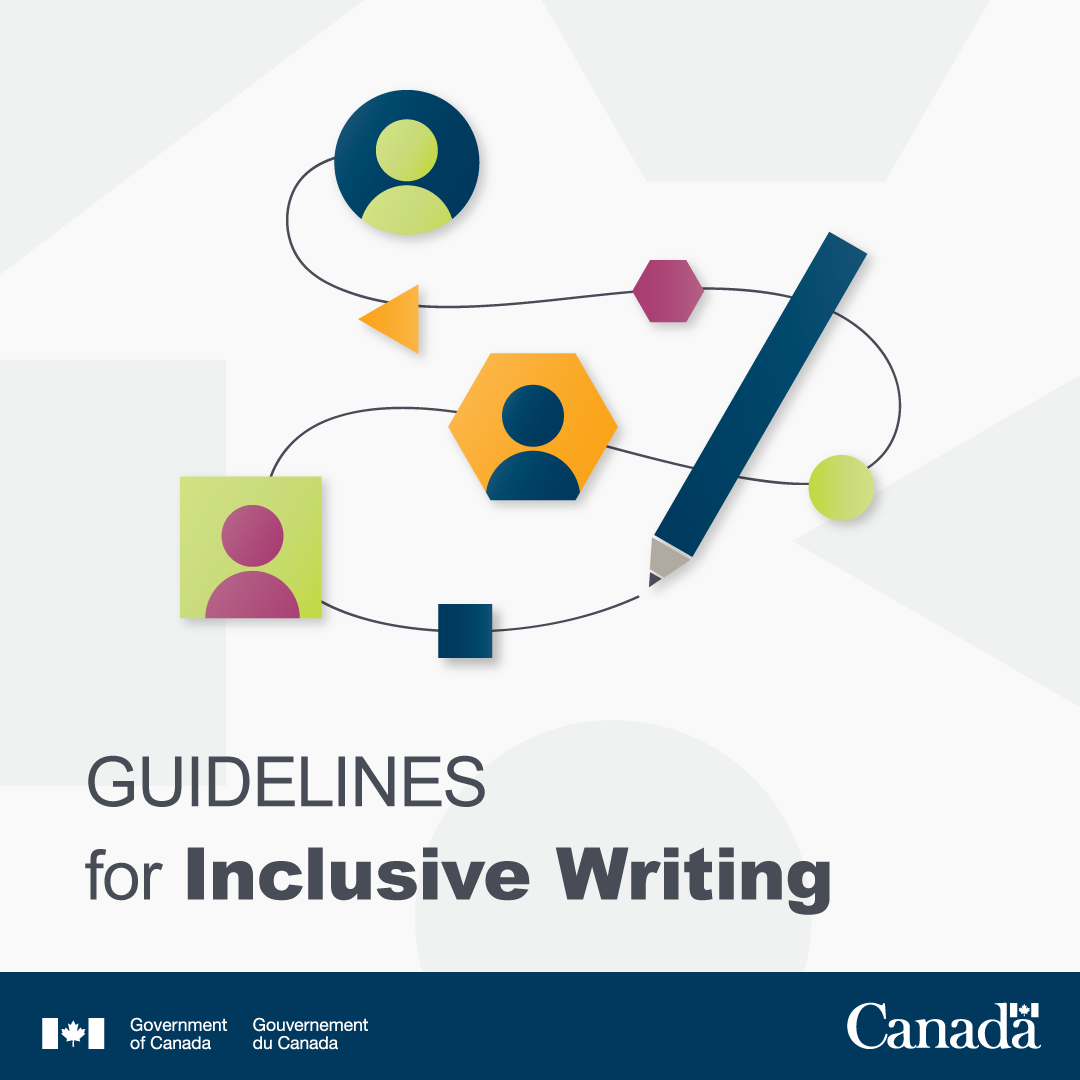 Download the image |
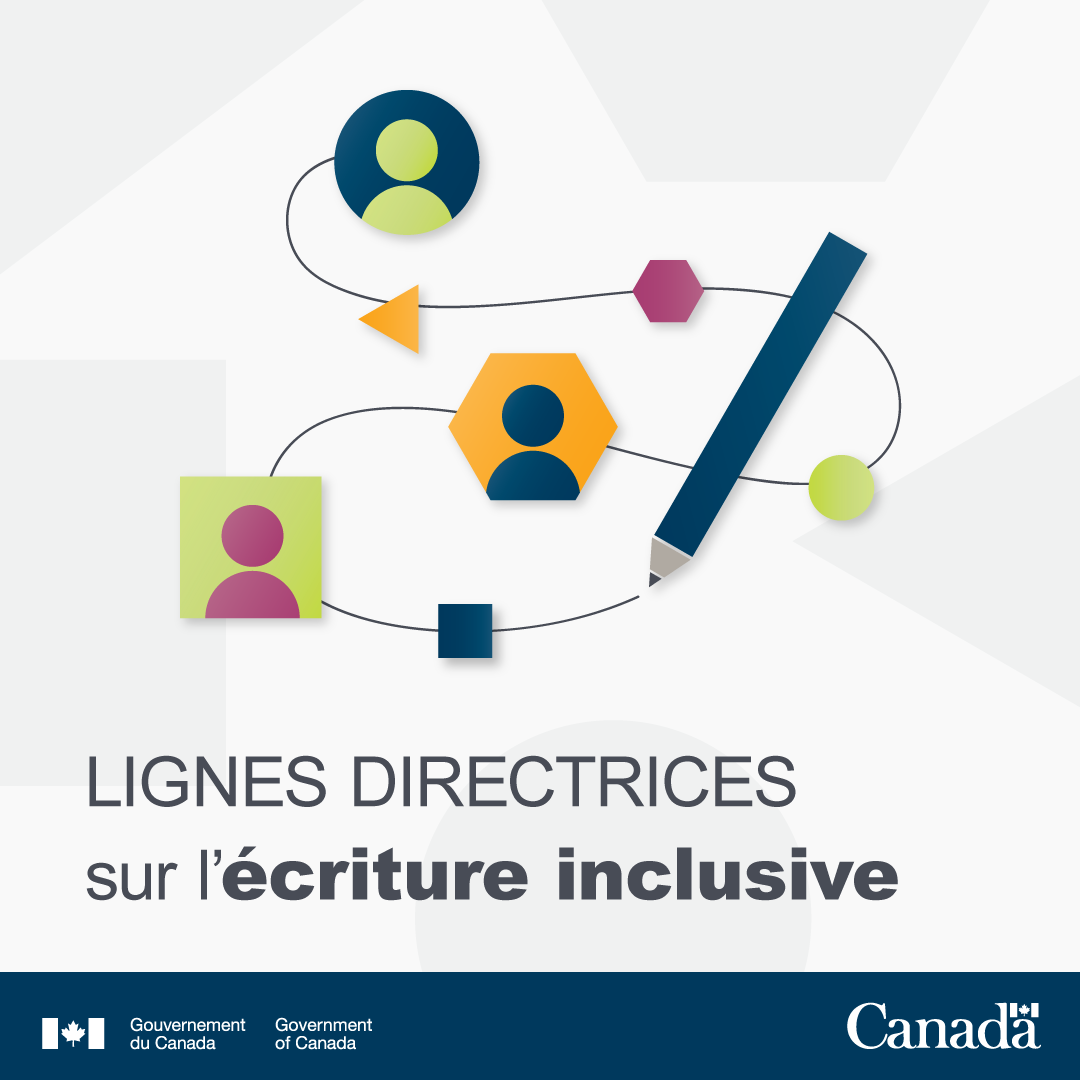 Download the image |
INTERNAL COMMUNICATIONS ON SCREENS
The following bilingual images can be used to promote the Guidelines for Inclusive Writing in PowerPoint presentations and during MS Teams or Zoom meetings.
| POWERPOINT IMAGE AND BACKGROUND |
|
|
|
WEB BANNERS
Web banners of various sizes can be used to promote the guidelines for inclusive writing on your intranet pages and in carousels on your web pages.
| SIZE 653 X 194 |
|
Link text
Check out the Guidelines for Inclusive Writing developed by the Interdepartmental Working Group on Inclusive Writing. |
Texte du lien
Consultez les Lignes directrices sur l’écriture inclusive préparées par le Groupe de travail interministériel sur l’écriture inclusive. |
| SIZE 1400 X 338 |
|
|
|
| SIZE 1500 X 300 |
|
|
|
|
NOTE Here is the alternate text to be used to describe the image: English Three geometrical shapes (a blue disc, a yellow hexagon and a green square) are linked by a wavy line drawn by a pencil. The disc contains a green silhouette; the hexagon, a blue silhouette; and the square, a pink silhouette. On the line are four smaller geometric shapes: a yellow triangle, a pink hexagon, a green disc and a blue square. Text: “GUIDELINES for Inclusive Writing.” French Trois formes géométriques (disque bleu, hexagone jaune et carré vert) sont réunies par une ligne courbe se terminant par un crayon. Chaque forme contient une silhouette respectivement verte, bleue et rose. Sur la ligne courbe sont posées quatre formes géométriques plus petites (triangle, hexagone, disque et carré) reprenant les mêmes couleurs. Texte : « LIGNES DIRECTRICES sur l’écriture inclusive ». |
COMMUNICATIONS AND NEWSLETTERS
The Language Portal team has prepared one bilingual promotional text for you to use in your internal communications (for example, in an employee newsletter).
| Bilingual text – Target audience: Canadians with an interest in official languages and federal public servants |
||
Check out the Guidelines for Inclusive Writing!
Want to write more inclusively in English or French? Looking for inclusive writing principles and techniques to help you do just that? You can now access the Guidelines for Inclusive Writing on the Language Portal of Canada! The Guidelines for Inclusive Writing are designed to help the federal public service and any other organization produce writing that is free of discrimination based on gender, race, ethnicity or any other identity factor. The Guidelines outline principles for writing inclusive texts and describe practical techniques to use in various contexts. Another new resource is the Inclusionary and its French counterpart, the Inclusionnaire, which can help you find inclusive alternatives to gendered words and expressions. The Guidelines and the collections of inclusive solutions were developed by the Interdepartmental Working Group on Inclusive Writing, which is co‑chaired by Public Services and Procurement Canada (represented by the Translation Bureau), Women and Gender Equality Canada, and Canadian Heritage, and composed of various federal and provincial departments and agencies. These resources underwent extensive consultations with equity, diversity and inclusion networks, and language professionals and communications specialists. Check out these resources today! |
Consultez les Lignes directrices sur l’écriture inclusive!
Vous souhaitez écrire de façon inclusive en français ou en anglais? Vous voulez connaître les principes et procédés d’écriture inclusive qui vous permettront d’y arriver ou souhaitez obtenir des outils et des ressources fiables? Vous pouvez maintenant consulter les Lignes directrices sur l’écriture inclusive dans le Portail linguistique du Canada! Ces lignes directrices sont conçues pour aider la fonction publique fédérale et toute autre institution intéressée à adopter une écriture évitant toute discrimination, qu’elle soit liée au genre, à la race, à l’origine ethnique, à la capacité ou à tout autre facteur identitaire. Elles présentent des principes permettant de rédiger des textes inclusifs et des procédés concrets parmi lesquels choisir selon le contexte. Autres nouveautés : l’Inclusionnaire et son pendant anglais l’Inclusionary vous permettent de trouver des solutions inclusives pour remplacer des mots genrés désignant ou qualifiant des personnes. Les Lignes directrices et les recueils de solutions inclusives ont été préparés par le Groupe de travail interministériel sur l’écriture inclusive, coprésidé par Services publics et Approvisionnement (représenté par le Bureau de la traduction), Femmes et Égalité des genres Canada et Patrimoine canadien. Ces ressources ont fait l’objet de vastes consultations, notamment auprès de réseaux d’équité, de diversité et d’inclusion ainsi que de spécialistes de la langue et des communications. Consultez ces ressources dès maintenant! | |
Contacting the Language Portal of Canada team If you have any questions or would like more information on this promotional kit, please write to the Language Portal team at the following address: noslangues.ourlanguages@tpsgc-pwgsc.gc.ca. |
